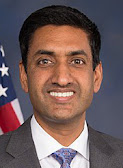 |
| Reed Anfinson with a copy of his Swift County Monitor-News (Associated Press photo by David Goldman) |
The headline in the
Swift County Monitor-News was perhaps alarming, but nothing unusual in a global pandemic: “Covid-19 cases straining rural clinics, hospitals, staff,” over a story in which health officials urged residents of the western Minnesota county, population 9,838, to protect themselves by getting vaccinated.
"But ask around Benson, stroll its three-block business district, and some would tell a different story,"
reports Tim Sullivan of
The Associated Press. The 136-year-old weekly "is not telling the truth," they say. "The vaccine is untested, they say, dangerous. And some will go further: People, they’ll tell you, are being killed by Covid-19 vaccinations."
"One little town. Three thousand people. Two starkly different realities," Sullivan writes. "It’s another measure of how, in an America increasingly split by warring visions of itself, division doesn’t just play out on cable television, or in mayhem at the U.S. Capitol. It has seeped into the American fabric, all the way to Benson’s 12th Street, where two neighbors -- each in his own well-kept, century-old home -- can live in different worlds."
Sullivan continues, "In one house is Reed Anfinson, publisher, editor, photographer and reporter for the Monitor-News. Most weeks, he writes every story on the paper’s front page. He wrote that story on clinics struggling with Covid-19. He’s not the most popular man in the county. Lots of people disagree with his politics. He deals with the occasional veiled threat. Sometimes, he grudgingly worries about his safety. While his editorials lean left, he works hard to report the news straight. But in an America of competing visions, some here say he has taken sides."
One of Anfinson's neighbors (they still watch each other's homes when one's away) is Jason Wolter, a pastor in the conservative
Missouri Synod of the Lutheran Church, "who reads widely and measures his words carefully. He also suspects Democrats are using the coronavirus pandemic as a political tool, doubts President Joe Biden was legitimately elected and is certain that Covid-19 vaccines kill people. He hasn’t seen the death certificates and hasn’t contacted health authorities, but he’s sure the vaccine deaths occurred: 'I just know that I’m doing their funerals.' He’s also certain that information 'will never make it into the newspaper.'"
Anfinson, 67, told Sullivan, “The easy part is speaking truth to power. The hard part is speaking truth to your community. That can cost you advertisers. That can cost you subscribers.” The paper's circulation is 2,000. He told Sullivan that he won’t consider following the example of some other rural publishers who have cut back on opinion pages or even eliminated them. Sullivan writes, "He says it’s his duty to expose people to new ideas, even unpopular ideas like stricter gun control. The editorial page is, he says 'the soul of a newspaper in a way. . . . I would be a traitor to the cause of journalism, of community newspapers. I would be cowardly.'"
Sullivan's story is not just about a courageous rural newspaper, but about the fact that national politics are causing local divisions. But it's mainly about Reed Anfinson, and partly about his wife Shelly, "a pro-life Republican who voted for Trump, at least the first time. It annoys her when news outlets talk down to conservatives. She worries that there are too few Republican journalists," Sulilivan reports. "She is often torn between support for Reed and worries over subscriber loss. Still, she’s been pressing him to tone down the politics."
“It is a struggle,” she told Sullivan. “I can tell these things to my business partner. It’s harder to tell them to my husband.”
Anfinson "mourns how some people see him as an enemy," Sullivan writes. "His newspaper should bind people together, he says. Instead, America and Benson are growing angrier. Contentious midterm elections loom."
“It’s kind of sad,” he told Sullivan. “But it would be foolish of me not to be aware of (my safety) with the sentiments out there.” Asked if he carries a weapon, he said he doesn't: “But I know where one is if I need it.”
UPDATE, Feb. 8: Sullivan
tells Chip Scanlan for
NiemanStoryBoard that he wishes he could have found an workable way to include some supporters of Anfinson and the Monitor-News in the story. Scanlan's story is followed by an annotated version of the story, in which he asks questions about the reporting and writing, and Sullivan answers.
UPDATE, Feb. 23: Anfinson received much supportive correspondence, and shared it with the International Society of Weekly Newspaper Editors, which shared it in its February newsletter:
 |
| For a larger version of the image, click on it. |










